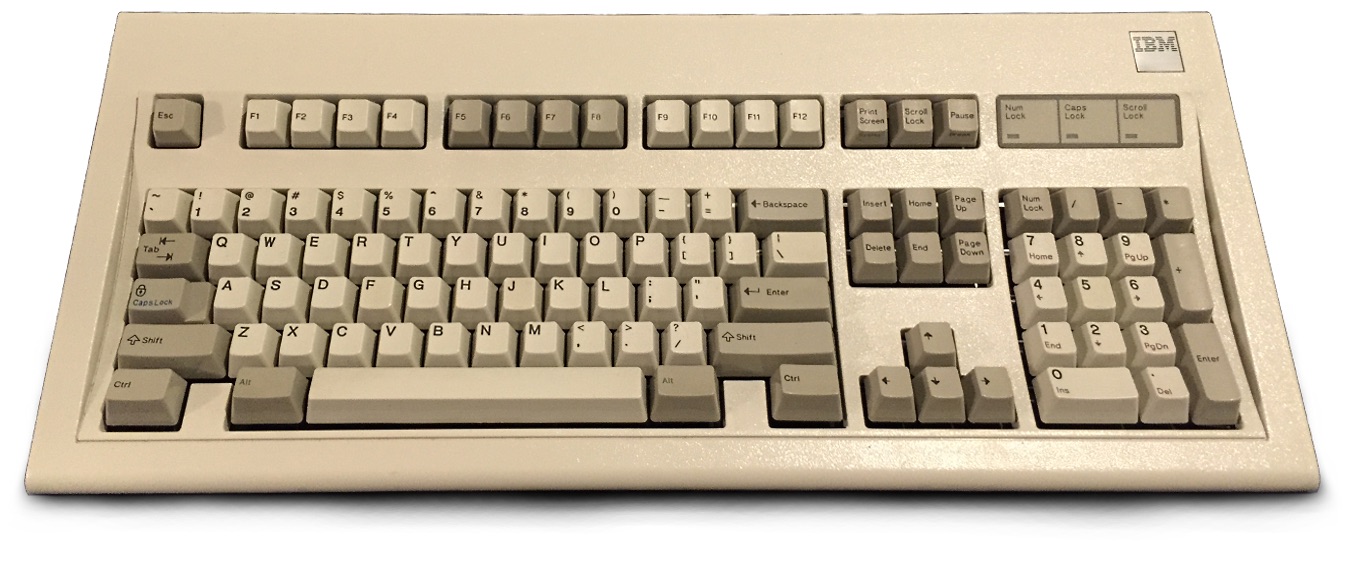About IBM keyboards
- Have you ever really thought about that keyboard you are using? Maybe you have always used keyboards like this, bundled with new desktop PCs with no visible choice of other kinds available from the PC manufacturer, you have probably got used to them and didn't know there are alternatives? I think I've been very lucky, having used computer keyboards for over 40 years starting with the Sinclair ZX80's terribly basic membrane keyboard and then progressing to the much nicer Televideo 910 and 912 RS-232 serial terminals when I moved to an IT job some years later although these required a fair amount of strength to push the keys down, which could become tiring after a while. Later still I moved on to a DEC VT52, VT100 and, eventually, the VT220 terminals and the DEC Rainbow PC. All of these had sensibly-sized keycaps with moulded depressions for the fingers, a nicely spread-out design and keys that really did move up and down.
- But it was always the IBM Selectric electric typewriter keyboard I liked the most at the time for its smooth and longer key travel and it wasn't long before IBM launched the IBM Personal Computer in 1980 with a keyboard (the Model F) that captured much of feel of the typewriter keyboard. In 1986 IBM added the higher-spec IBM PC AT (for Advanced Technology) computer to their range along with a wider and better keyboard, the Model M with a key layout borrowed from DEC's LK201 keyboard supplied with their VT220 terminals, which popularised the 'inverted T' arrangement of the curosr keys. Since then the Model M keyboard's key count and layout has become the de facto standard for computer keyboards but, sadly, the build quality and feel of the keyboards from almost all other manufacturers these days is nowhere near as good.

- Costing over £100 each in 1986, the Model M is a heavy keyboard built on a solid steel chassis and uses the 'buckling spring' mechanism for the keys, providing a 'clicky' keyboard that provides both aural and tactile feedback to the user that the key has actually been depressed fully to input the desired character.
- Frankly, I find the keyboards HP supplies with their current desktop PCs and workstations horrible, with flat keycaps with very little travel and no tactile or audible feedback. And the Magic and wired keyboards Apple supplies with their current Mac desktop range are even worse which is a real shame since the systems themselves are so nice to use in all other respects (in fact, it has to be said the keyboards on the MacBook Air and MacBook Pro laptops are much nicer to use than their deskstop siblings).
- Fortunately there has always been a minority of computer users - mostly heavy keyboard users such as professional programmers, data entry staff, etc - who have sought alternatives and apart from buying genuine original IBM keyboards from the 1980's & 1990's on the second-hand market, the keyboard manufacturer Unicomp which was founded in 1996 by ex-IBM and ex-Lexmark employees, has been making near-identical keyboards after having acquired the rights to the original buckling spring technology 25 years ago. More recently, the Model F Labs company that specialises in manufacturing the earlier IBM Model F keyboard have launched a range of Model M keyboards that are either identical to the IBM original or have modern enhancements such as USB interfaces, custom-sized cases & colours, etc as well as versions that can be used with a Mac - you'll not be disappointed by their range of keyboards!
- However, these don't come cheap but a more affordable option that would be acceptable to many users would be the Cherry G80-3000 keyboard, which has been in production since the Eighties with the same standard layout as the Model M with proper gold keypoint keyswitches (but not buckling spring) instead of a plastic membrane and is also much lighter than the IBM Model M. Also worth considering is a used DEC LK201 keyboard (or one of the Compaq-branded variants after HP took over DEC and eventually killed it off) - this keyboard's layout was in many ways the precursor to that of IBM's Model M but lacks the buckling spring technology and is nowhere near as nice to use. Still, it's better than most mainstream keyboards.
Andy Thomas
Research Computing Manager,
Department of Mathematics
last updated: 20.08.19

